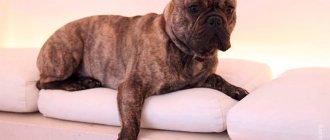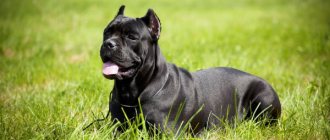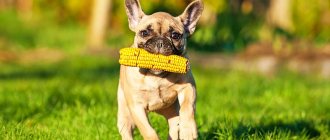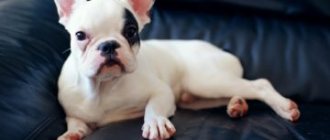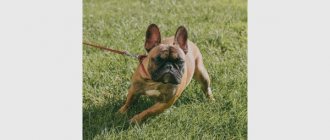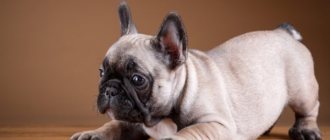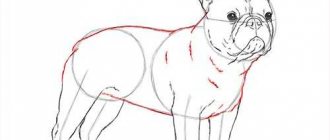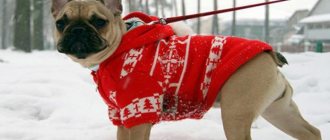The French bulldog is the result of the painstaking work of breeders, a breed that has passed through the centuries. Having begun their history as fighting and rat-catching dogs, bulldogs became close to people and acquired the status of a family and soul pet. Surprisingly smart, wayward and brave, but at the same time loyal and sensitive, French bulldogs are ideal for a novice dog breeder.
Their small size and short hair make it possible to keep the animal in an apartment. This breed gets along well with children, adapts to the owner’s rhythm of life, but has a very hard time dealing with his indifference and requires constant communication.
French Bulldog Standards
The French Bulldog belongs to the group of companion dogs. Compliance with breed standards is usually required for exhibition. Standard characteristics for the French are set by the FCI. They describe and establish requirements not only for the dog’s physique and coat color.
The bulldog standard describes:
- coat structure;
- color of the iris, nose and claws;
- ear shape;
- tail shape;
- dog movements;
- features of behavior and character, etc.
In addition, the international standard establishes a list of deficiencies and disqualifying defects. Further in the article, what a standard French bulldog should look like.
Breed parameters (weight, height)
The Frenchie's body weight depends on gender. Thus, males can weigh from 9 to 14 kilograms, and females - from 8 to 13 kilograms. In this case, a slight excess of 300-500 grams is acceptable.
The height at the withers of male Frenchies ranges from 26 to 35 centimeters. The height of females is from 23 to 32 centimeters. As in the case of weight, it is allowed to exceed or decrease the indicator within one centimeter.
Exterior
Head
The French Bulldog can have three types of skull – square, narrow and heavy. In this case, only a square head fits the standard. In addition, folds and wrinkles should be clearly visible. In the place where the ears are located, the skull is wider. The forehead of a standard Frenchman is rounded, resembling a dome in shape.
Muzzle
The muzzle of a purebred dog is short and wide. Symmetrical folds are distributed over the surface of the muzzle.
Bite
According to the standard, the French must have an overbite - a bite characterized by the location of the lower incisors in front of the upper ones. Another name for this bite is “bulldog jaw.” The only thing is that it is unacceptable for the teeth to be visible.
Powerful jaws (both upper and lower) combined with a short, strong neck provide the bulldog with amazing grip strength. Franz is capable of clenching his jaw for a very long time, holding some “victim” in his teeth. Only the owner's command forces them to loosen their grip.
Front legs
According to the standard, the front paws of a bulldog have the following characteristics:
- Short length. There cannot be a standard French Bulldog with long legs.
- The paws are parallel and widely spaced. When standing, they are slightly moved to the sides.
- The muscles of the forelimbs are powerful.
- Elbows are pressed to the body.
- The paws are round, collected in a “lump”.
- The claws are strong. The color of the claws depends on the color of the coat: in brindle Frenchies they are black, and in fawn or spotted ones they are light.
This structure of the front paws leads to rapid fatigue of the Frenchie after walking. The fact is that the load that is intended for the bones is transferred to the muscles.
Hind legs
The bulldog's hind legs are longer than the front legs. The muscles are also well defined. Due to the difference in paw length, the back of the Frenchie's body is slightly higher.
If you examine the Frenchie's hind legs from behind, you will notice:
- muscularity of the thighs. In addition, they are wide;
- hock joints set low;
- paws less rounded.
Back
The Frenchman's back is wide at the shoulders, harmoniously tapering towards the hips. When viewed from above, the back is pear-shaped. The length of the back ranges from 27 to 40 centimeters. It depends on the gender and age of the dog.
Tail
French Bulldogs are born with a short tail. The shape of the tail depends on the location of the vertebrae and can be different. For example, the tail can be a “corkscrew”, “knot”, etc.
According to the standard, it is not the shape of the tail that is more important, but its location. So, the correct tail is set low. If, during an excited state, the Frenchie's tail begins to rise higher than the back line, this is a fault in the breed.
Coat color
The bulldog's coat should lie close to the body, be short and thick. The wool is soft to the touch. Wavy or long fur is not allowed.
The standard provides for three types of correct color for a Frenchie:
- Pale yellow. This is a whole group of colors, which includes all sorts of shades from bright red to coffee.
- Spotted. With this color, the main color of the Frenchie is white. The spots should be large. At the same time, dogs with pure white fur are also considered spotted.
- Brindle. Tiger fur is a mixture of red and black of varying intensities. In this case, different degrees of displacement of one color by another are acceptable.
Behavior and character
French bulldogs are dogs with a balanced disposition. Even despite the occasional desire to get involved in a fight, the French are peace-loving dogs. But lack of education or improper training will lead to the pet being either cowardly or overly aggressive.
In addition, the Frenchman cannot stand being alone for long periods of time and always misses his owner. This is a sociable dog who loves to spend time with his family. Even if the dog is offended, it is easy to appease him with affection and love.
Frenchies get along easily with small children and other pets. However, male Frenchies are not averse to getting into a fight. The small size of a dog does not mean small strength. In fact, the French bulldog is a very strong and loyal dog.
Difference with mini
The weight of a mini bulldog rarely exceeds 8 kg. Many people think that this is a separate breed of dog, but this is not so. Such animals do not have the right to participate in breeding and exhibitions.
The mini bulldog is the result of a mutation, a genetic marriage caused by the predominance of the dwarfism gene.
It may seem that due to their size, these dogs are convenient for keeping in an apartment, and generally have a prettier appearance.
Unscrupulous breeders profit from this.
They deliberately breed dogs and thereby increase the number of individuals with genetic abnormalities.
The lifespan of mini bulldogs is up to 11 years, while their “large” counterparts live up to 15 years. This is all due to improper development of the skeleton, external and internal deformations caused by the uneven formation of the body.
Along with mini-bulldogs, ordinary “Frenchies” also have a number of genetic predispositions to diseases:
- Breathing problems due to shortened muzzle.
- Spinal deformities (dislocations, hernias, curvatures).
- Loss of eyeballs.
- Problems with natural childbirth.
- Intolerance to too low and high temperatures.
- Tendency to obesity.
Dogs are not suitable for constant keeping on the street; keeping them in enclosures and on chains is absolutely prohibited. Firstly, French bulldogs do not tolerate temperature fluctuations well, and secondly, despite the fact that the dog is quite willful and independent, it needs constant contact with a person, without whom the animal will be sad and feel unwell.
Advantages and disadvantages of bulldogs
This breed has many advantages:
- Possibility of living in apartment conditions. The French Bulldog is a toy dog, so it does not require a huge amount of space.
- Ease of transportation. Compact sizes make it easy to hold the dog in your arms.
- Love of life and activity.
- Developed ingenuity.
- Adaptation to any conditions of detention.
- Vigilance and attentiveness. The French Bulldog is a real live alarm. The dog will always let the owner know if he hears strange and suspicious sounds.
- Franz is trainable. This is a smart breed. And the bulldog’s fighting origins and muscular body create the image of a real defender. With proper training, you can keep your dog's aggression under control and direct it in the right direction.
- Ease of care. Since the bulldog has short hair, it practically does not get dirty and does not smell. And combing a short coat of fur is very easy.
Of course, like any breed, the French Bulldog has several disadvantages:
- The Frenchman does not tolerate frost and heat well. Therefore, in hot weather, the bulldog is not walked, and in cold weather, warm suits are put on the dog.
- Tendency to fungus. If you do not inspect the folds and deep wrinkles on the Frenchie's face, they may develop fungus or skin diseases. You need to regularly wipe hard-to-reach places with a damp cloth.
- The special structure of the respiratory system leads to constant snoring. In addition, the French are prone to flatulence and excessive salivation.
- Milk intolerance.
- Due to its heavy skull, the French Bulldog is a poor swimmer.
- Intolerance of loneliness. If the owner pays little attention to the pet, he will begin to take revenge. For example, he will make a mess in the apartment and start biting.
- Often fights with other animals.
Story
It is believed that the ancestors of this breed were the Old English Bulldogs - fighting dogs bred in England in the 17th century to play against other animals. When public interest in animal fighting waned, small bulldogs began to be kept as pets, plus these dogs were as good as cats at catching rats - a very useful skill in the midst of rat epidemics.
When English emigrants brought dogs with them to France after the industrial revolution, small bulldogs immediately fell in love with high society. This breed was expensive, and keeping such a dog was a sign of wealth and status. French breeders worked on the breed, giving it more “miniature” attractive features, and in 1896 French bulldogs were first presented at a dog show at the Westminster Kennel Club.
French bulldogs appeared in Russia at the beginning of the 20th century.
And they also became an object of luxury and status among Russian fashionistas.
The St. Petersburg press of 1913 talks about the tenth anniversary dog show.
At which “St. Bernards, Great Danes, and excellent hunting greyhounds were presented, but the most fashionable dog is still the French bulldog.”
Around the same time, this breed was brought to the United States, where it immediately fell in love with dog breeders. It was in the States that the world's first exhibition of French bulldogs took place. The price of a dog started from three hundred dollars and could reach up to a thousand, covering the cost of Ford cars. Now in America there is a decent community of bulldogs with new atypical colors, but in general characteristics these dogs are slightly smaller than European ones - their average weight is 12 - 13 kg.
Disqualifying vices of the French
The presence of the following external defects will not allow the French Bulldog to participate in dog shows:
- different colors of irises;
- the nose is not black;
- malocclusion: straight, scissor;
- when the jaws close, fangs are visible;
- cleft lip;
- the ears are not standing;
- dewclaws. Typically, the dewclaw is the thumb, which is located above the foot. It is a vestigial part of the body, that is, it does not perform any functions;
- incorrect coat color;
- no tail or docked tail;
- cryptorchidism (both bilateral and unilateral).
Behavior, temperament
French bulldogs are easy-going, sociable and kind dogs. They learn basic commands very well. They get along quite well with other pets if they are properly raised from an early age.
Until 5-6 years of age, these are very active and curious creatures; in maturity they become calmer and quieter.
Return to content
Questions and answers
What should a French Bulldog be like?
By standard, the French Bulldog is a stocky, compact dog with powerful short legs, a large skull and a wrinkled muzzle. The normal bite of a Frenchie is an underbite. There should also be erect ears and short hair that lies close to the body.
What kind of tail should a French Bulldog have?
French Bulldogs are born with a short tail. The tail can be a “corkscrew”, “knot”, etc. But according to the standard, it is not the shape of the tail that is more important, but its location. The correct tail is set low.
Historical reference
More recently, namely on April 9, 2015, the Fédération Cynologique Internationale (FCI) released a new standard for the French Bulldog breed. The history of the origin of this breed is very confusing. According to one version, it traces its roots to the Molossians, widely known since the times of the Roman Empire . It is also believed that the English Alans are related to its origin.
This is interesting! The French Bulldog we know today is the result of numerous breedings carried out by enthusiastic breeders in poor areas of Paris in the 1880s. In those days, the ancestors of these dogs were kept by porters and traders in Parisian markets, butchers and coachmen. These dogs warned of strangers with loud barks and also successfully caught rats.
But soon, thanks to their exotic appearance and flexible character, they were able to gain popularity among representatives of high society and artistic bohemia. The popularity of the breed grew rapidly and spread very quickly outside of France.
Return to content
Health, illness
The life expectancy and health status of French bulldogs directly depend on the quality of their care and living conditions. However, the breed as a whole is not distinguished by good health.
The anatomical features of an animal are one of the causes of various diseases and injuries.
The most common diseases:
- food allergies;
- eye diseases – conjunctivitis, cataracts, eyeball prolapse;
- dermatitis and inflammation of the fingertips;
- entropion of the eyelid;
- hair loss;
- urolithiasis disease;
- colds;
- bracheocephalic syndrome;
- obesity;
- problems with the spine.
In addition, “Frenchies” often suffer from diarrhea, which can be caused by a change in diet, infection, worms, colds, teething, or poisoning.
If there are any changes in health, the pet should be shown to a specialist.
Nutritional Features
French bulldogs require careful selection of their diet, as they are prone to gastrointestinal problems, food allergies and obesity. Choose high-quality ready-made dry food only from holistic and super-premium classes. Buy a bowl for your pet with a vertical stand, adjustable in height, provide access at the level of the dog’s chest. This will make drinking and eating more convenient. Change the water every day and remove any leftover food immediately.
Want to eat
If you are planning natural feeding, follow the list of recommended products:
- raw lean meat, cut into pieces;
- boiled sea fish without bones;
- porridge;
- seasonal vegetables and fruits (primarily green);
- chicken eggs;
- fermented milk products (cause diarrhea in some dogs).
Completely exclude fatty meat, river fish, smoked meats, sweets, baked goods, and gas-forming products (beans, cabbage) from your dog’s diet. Puppies up to 2 months are fed 6 times a day, at 3 months - 5 times a day, at 4-7 months - 4 times, at 8-12 months - 3 times. You can switch to two meals a day per year. Monitor portion sizes as French Bulldogs tend to overeat. Do not give very hot or cold food/drink.
Socialization
Until 16 weeks, the character of the French Bulldog is soft, like plasticine. During this period, he should be actively socialized, taught basic commands and rules of behavior.
As soon as a small French bulldog appears in the house, he is immediately introduced to the household and allowed to adapt to the unusual environment. The puppy should not feel abandoned. With a lack of attention, Frenchies become fearful or angry.
A French Bulldog and children are sure to make great friends. Only the guys need to immediately explain that the dog is also a member of the family and requires respectful treatment. It is better not to leave children alone with a pet. They may accidentally hurt him, which will force the dog to defend himself.
Difficulties may arise if a child is born in a family where there is a French coat. An insufficiently socialized dog who has not dealt with infants before will be wary of a new little person. In this case, you need to act gently and patiently. It is better for novice dog breeders to contact a zoopsychologist or dog handler. Then the French bulldog and children will definitely find a common language.
The Frenchman has a complex relationship with other four-legged neighbors. You cannot leave your dog with guinea pigs, hamsters, parrots, or rabbits - it will show its predatory nature. A French bulldog and a cat don't always get along either. You need to either get a puppy when the second animal is already in the house, or take both babies at the same time so that they grow up together.
The mini French bulldog is more loyal to pets. However, he is also able to catch a mouse running past. On a walk, a baby can fearlessly bark at a larger dog, and, if necessary, rush to protect the owner.
The socialized Mini French Bulldog enjoys playing with other small breeds. For example, a Chihuahua.
How to choose a puppy
If you want to purchase a French Bulldog puppy, then you definitely need to find a trusted kennel or breeder. This is the only way you can buy a puppy that meets all the requirements:
- thoroughbred;
- healthy;
- with all necessary vaccinations;
- without “surprises” in the form of cowardice or aggression in character.
From the kennel you must receive a passport with vaccinations, the dog's pedigree and a puppy card. It is better to choose the future of your family member personally. This way you can get to know not only the puppy, but also its breeders. See the conditions in which he and his parents are kept.
Do not buy a dog second-hand at the market or through dubious advertisements. Very often, dishonest sellers sell sick or defective animals in this way.
Choose from the entire litter a large and active baby. He should look healthy and show interest in the world around him. Experts advise taking a puppy to a new home from eight weeks, or better yet, from ten to twelve weeks. to the breeder about the character of the puppy's parents. After all, not only diseases, but also many habits are inherited.
Character
Frenchies have a typical Molosser character - loyal, devoted, noble, but sometimes disobedient and stubborn. During the selection process, they became sociable, cheerful, playful, but retained a tendency towards possessiveness.
Despite his harsh exterior, the Frenchman is very sociable. The dog needs constant communication with its owner. He must understand that he is loved and appreciated. It does not suffer from short-term separation, but patiently waits for the owner's return. The pet subtly senses the mood and does not impose itself if the person wants to be alone.
Frenchies are smart, but they are quite difficult to train. Classes should be short and varied so that the dog does not lose interest. In adolescence, the Frenchman always tests the owner's strength, trying to take a leading position. Pranks must be stopped, but the use of brute force is prohibited. The bulldog will remember the insult for a long time and will do something nasty in response.
The dwarf French bulldog is even cuter and more affectionate. His personality is more like a domestic cat than a dog. This is a real couch animal. Only in exceptional cases does a pet cause trouble - chewing things or furniture. If you surround your baby with care, he will be happy and will not become naughty.
The mini bulldog has average intellectual abilities. He is able to learn the necessary commands, but dogs are not purposefully trained so often - their innate laziness prevents them from being efficient. Some results can be achieved by teaching your child in a playful manner.

